air conditioning TOYOTA PROACE VERSO 2020 Owners Manual
[x] Cancel search | Manufacturer: TOYOTA, Model Year: 2020, Model line: PROACE VERSO, Model: TOYOTA PROACE VERSO 2020Pages: 418, PDF Size: 39.32 MB
Page 2 of 418
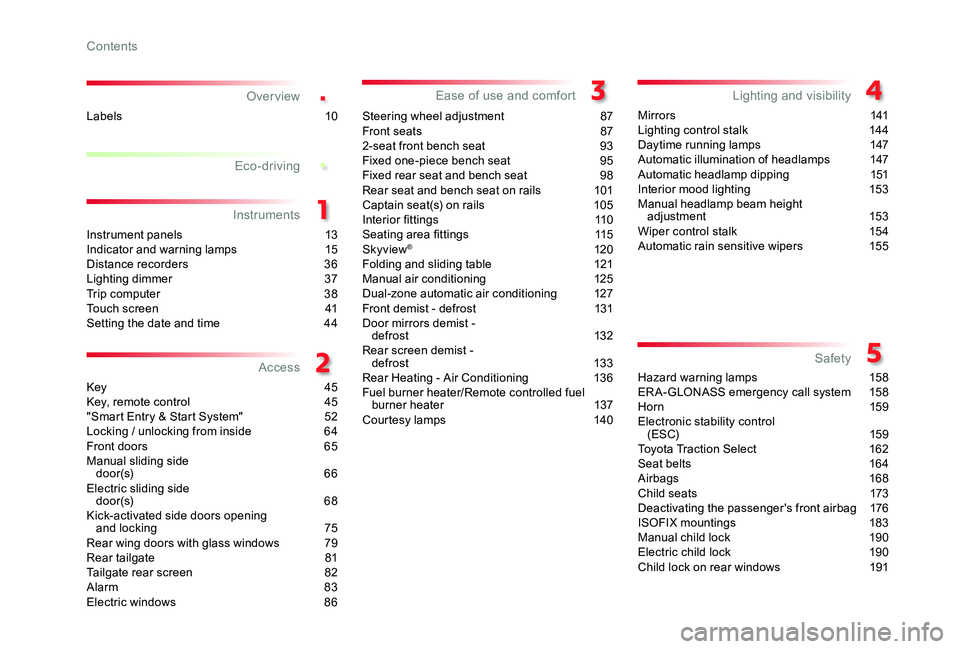
.
.
Over view
Instrument panels 13Indicator and warning lamps 15Distance recorders 36Lighting dimmer 37Trip computer 38Touch screen 41Setting the date and time 44
Key 45Key, remote control 45"Smart Entry & Start System" 52Locking / unlocking from inside 64Front doors 65Manual sliding side d o o r (s) 6 6Electric sliding side d o o r (s) 6 8Kick-activated side doors opening and locking 75Rear wing doors with glass windows 79Rear tailgate 81Tailgate rear screen 82Alarm 83Electric windows 86
Steering wheel adjustment 87Front seats 872-seat front bench seat 93Fixed one-piece bench seat 95Fixed rear seat and bench seat 98Rear seat and bench seat on rails 101Captain seat(s) on rails 105Interior fittings 110Seating area fittings 115Skyview® 120Folding and sliding table 121Manual air conditioning 125Dual-zone automatic air conditioning 127Front demist - defrost 131Door mirrors demist - defrost 132Rear screen demist - def rost 13 3Rear Heating - Air Conditioning 136Fuel burner heater/Remote controlled fuel burner heater 137Courtesy lamps 140
M i r r o r s 141Lighting control stalk 144Daytime running lamps 147Automatic illumination of headlamps 147Automatic headlamp dipping 151Interior mood lighting 153Manual headlamp beam height adjustment 153Wiper control stalk 154Automatic rain sensitive wipers 155
Hazard warning lamps 158ER A-GLONASS emergency call system 15 8Hor n 159Electronic stability control (ESC) 159Toyota Traction Select 162Seat belts 164Airbags 168Child seats 173Deactivating the passenger's front airbag 176ISOFIX mountings 183Manual child lock 190Electric child lock 190Child lock on rear windows 191
Eco-driving
Instruments
Access
Ease of use and comfortLighting and visibility
Safety
Labels 10
Contents
Page 6 of 418
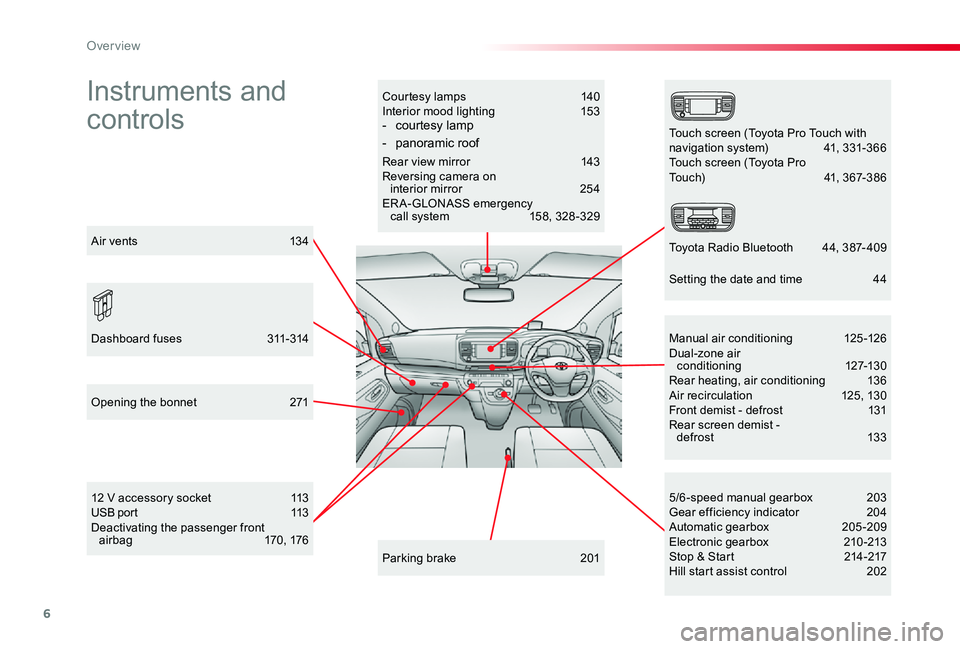
6
Instruments and
controls
Courtesy lamps 140Interior mood lighting 153- courtesy lamp
- panoramic roof
Rear view mirror 143Reversing camera on interior mirror 254ERA-GLONASS emergency call system 158, 328 -329
12 V accessory socket 113USB port 113Deactivating the passenger front airbag 170, 176
5/6 -speed manual gearbox 203Gear efficiency indicator 204Automatic gearbox 205-209Electronic gearbox 210 -213Stop & Start 214-217Hill start assist control 202
Manual air conditioning 125-126Dual-zone air conditioning 127-130Rear heating, air conditioning 136Air recirculation 125, 130Front demist - defrost 131Rear screen demist - def rost 13 3
Parking brake 201
Opening the bonnet 271
Dashboard fuses 311-314
Touch screen (Toyota Pro Touch withnavigation system) 41, 331-366Touch screen (Toyota ProTouch) 41, 367-386
Toyota Radio Bluetooth 44, 387- 409Air vents 134
Setting the date and time 44
Over view
Page 8 of 418
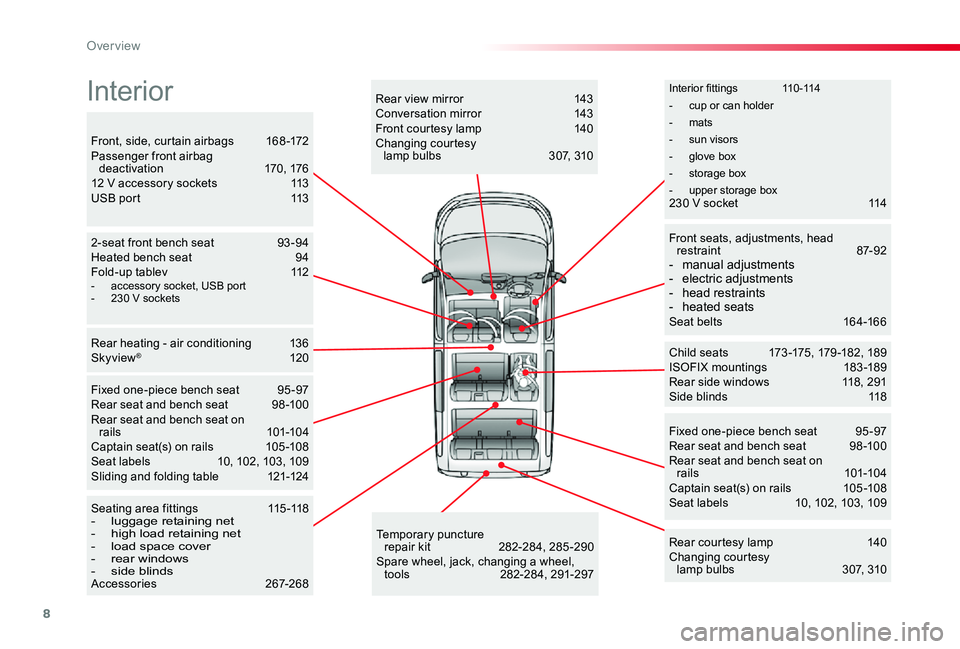
8
Interior fittings 110-114
- cup or can holder
- mats
- sun visors
- glove box
- storage box
- upper storage box
Child seats 173 -175, 179 -182, 189ISOFIX mountings 183 -189Rear side windows 118, 291Side blinds 118
Fixed one-piece bench seat 95 -97Rear seat and bench seat 98 -100Rear seat and bench seat on rails 101-104Captain seat(s) on rails 105 -108Seat labels 10, 102, 103, 109
2-seat front bench seat 93 -94Heated bench seat 94Fold-up tablev 112
Rear heating - air conditioning 136Skyview® 120
Temporary puncture repair kit 282-284, 285 -290Spare wheel, jack, changing a wheel, tools 282-284, 291-297
Seating area fittings 115 -118- luggage retaining net- high load retaining net- load space cover- rear windows- side blindsAccessories 267-268
Rear courtesy lamp 140Changing courtesy lamp bulbs 307, 310
Rear view mirror 143Conversation mirror 143Front courtesy lamp 140Changing courtesy lamp bulbs 307, 310Front, side, curtain airbags 168 -172Passenger front airbag deactivation 170, 17612 V accessory sockets 113USB port 113
Front seats, adjustments, head restraint 87-92- manual adjustments- electric adjustments- head restraints- heated seatsSeat belts 164-166
Fixed one-piece bench seat 95 -97Rear seat and bench seat 98 -100Rear seat and bench seat on rails 101-104Captain seat(s) on rails 105 -108Seat labels 10, 102, 103, 109Sliding and folding table 121-124
Interior
- accessory socket, USB port- 230 V sockets
230 V socket 114
Tool box 282-283
Over view
Page 11 of 418
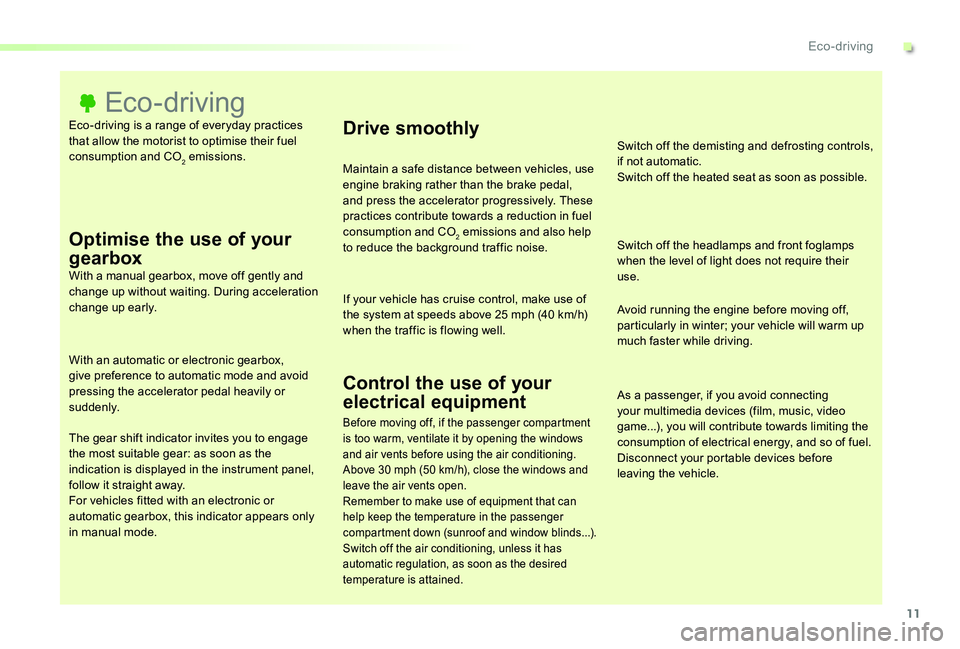
11
Eco-driving is a range of everyday practices that allow the motorist to optimise their fuel consumption and CO2 emissions.
Eco- driving
Optimise the use of your
gearboxWith a manual gearbox, move off gently and change up without waiting. During acceleration change up early.
With an automatic or electronic gearbox, give preference to automatic mode and avoid pressing the accelerator pedal heavily or suddenly.
The gear shift indicator invites you to engage
the most suitable gear: as soon as the indication is displayed in the instrument panel, follow it straight away.For vehicles fitted with an electronic or automatic gearbox, this indicator appears only in manual mode.
Drive smoothly
Maintain a safe distance between vehicles, use engine braking rather than the brake pedal, and press the accelerator progressively. These practices contribute towards a reduction in fuel consumption and CO2 emissions and also help to reduce the background traffic noise.
If your vehicle has cruise control, make use of the system at speeds above 25 mph (40 km/h) when the traffic is flowing well.
Control the use of your
electrical equipment
Switch off the demisting and defrosting controls, if not automatic.Switch off the heated seat as soon as possible.
Switch off the headlamps and front foglamps when the level of light does not require their use.
Avoid running the engine before moving off, particularly in winter; your vehicle will warm up much faster while driving.
As a passenger, if you avoid connecting your multimedia devices (film, music, video game...), you will contribute towards limiting the consumption of electrical energy, and so of fuel.Disconnect your portable devices before leaving the vehicle.
Before moving off, if the passenger compartment is too warm, ventilate it by opening the windows and air vents before using the air conditioning.Above 30 mph (50 km/h), close the windows and leave the air vents open.Remember to make use of equipment that can help keep the temperature in the passenger compartment down (sunroof and window blinds...).Switch off the air conditioning, unless it has automatic regulation, as soon as the desired temperature is attained.
.
Eco-driving
Page 125 of 418
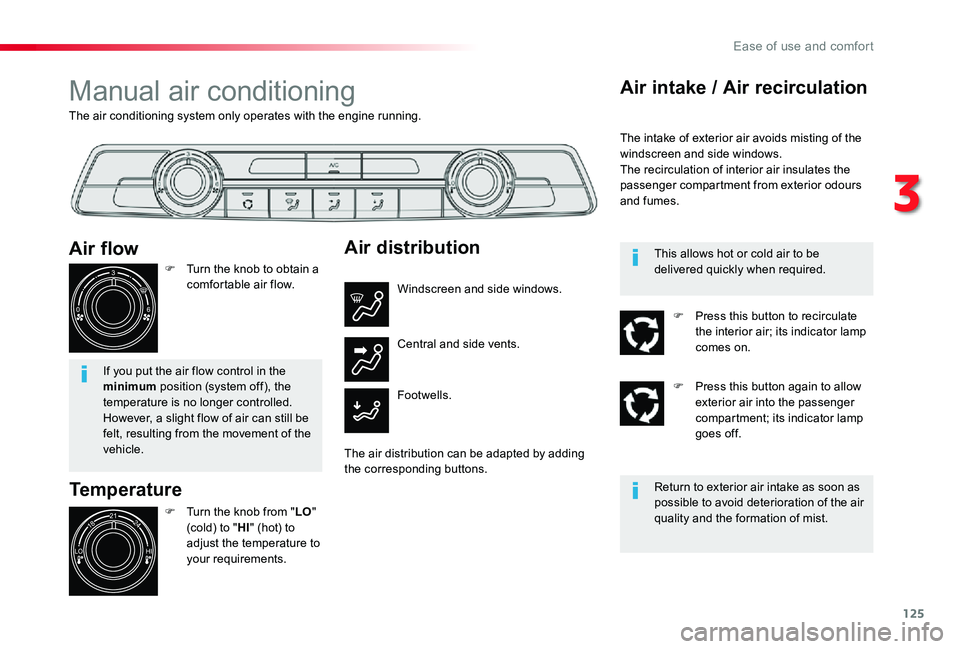
125
The air conditioning system only operates with the engine running.
Manual air conditioning
Temperature
F Turn the knob from "LO" (cold) to "HI" (hot) to adjust the temperature to your requirements.
Air flow
F Turn the knob to obtain a comfortable air flow.
If you put the air flow control in the minimum position (system off), the temperature is no longer controlled. However, a slight flow of air can still be felt, resulting from the movement of the vehicle.
Air distribution
Windscreen and side windows.
Footwells.
Central and side vents.
The air distribution can be adapted by adding the corresponding buttons.
Air intake / Air recirculation
The intake of exterior air avoids misting of the windscreen and side windows.The recirculation of interior air insulates the passenger compartment from exterior odours and fumes.
Return to exterior air intake as soon as possible to avoid deterioration of the air quality and the formation of mist.
This allows hot or cold air to be delivered quickly when required.
F Press this button to recirculate the interior air; its indicator lamp comes on.
F Press this button again to allow exterior air into the passenger compartment; its indicator lamp goes off.
3
Ease of use and comfort
Page 126 of 418
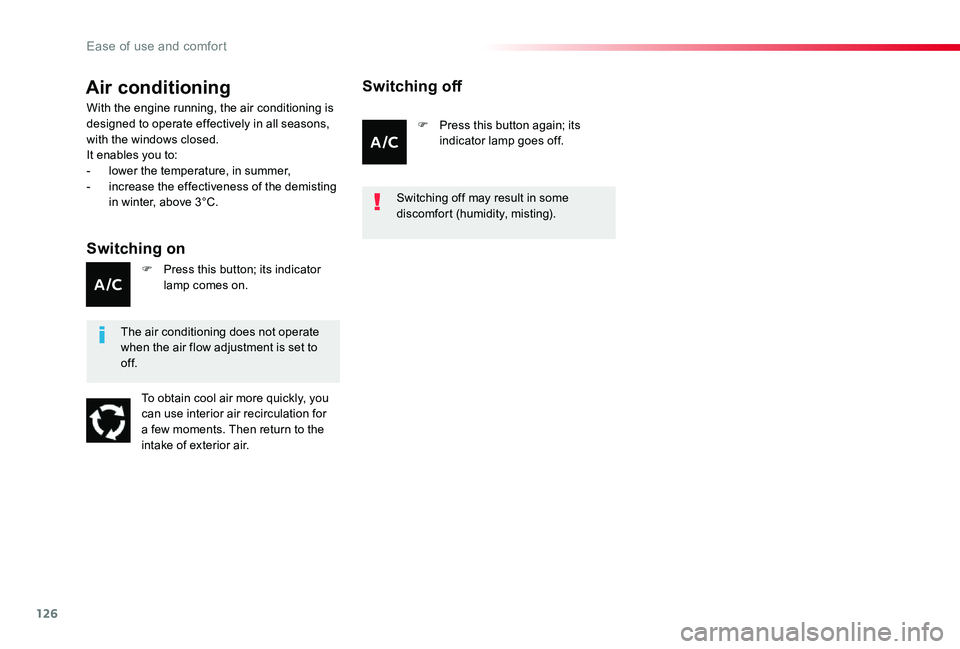
126
Air conditioning
Switching on
With the engine running, the air conditioning is designed to operate effectively in all seasons, with the windows closed.It enables you to:- lower the temperature, in summer,- increase the effectiveness of the demisting in winter, above 3°C.
To obtain cool air more quickly, you can use interior air recirculation for a few moments. Then return to the intake of exterior air.
F Press this button; its indicator lamp comes on.
F Press this button again; its indicator lamp goes off.
Switching off
The air conditioning does not operate when the air flow adjustment is set to of f.
Switching off may result in some discomfort (humidity, misting).
Ease of use and comfort
Page 127 of 418
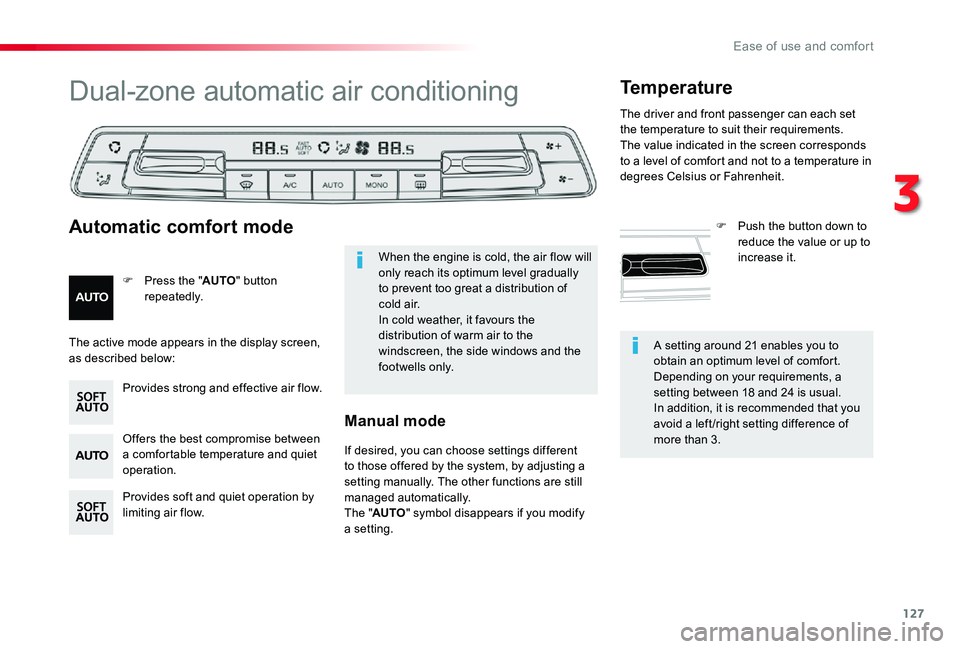
127
A setting around 21 enables you to obtain an optimum level of comfort. Depending on your requirements, a setting between 18 and 24 is usual.In addition, it is recommended that you avoid a left /right setting difference of more than 3.
Dual-zone automatic air conditioning
Offers the best compromise between
a comfortable temperature and quiet operation.
Provides soft and quiet operation by limiting air flow.
Provides strong and effective air flow.
F Press the "AUTO" button repeatedly.
Automatic comfort mode
Temperature
F Push the button down to reduce the value or up to
increase it.When the engine is cold, the air flow will only reach its optimum level gradually to prevent too great a distribution of c o l d a i r.In cold weather, it favours the distribution of warm air to the windscreen, the side windows and the footwells only.
The active mode appears in the display screen, as described below:
If desired, you can choose settings different to those offered by the system, by adjusting a setting manually. The other functions are still managed automatically.The "AUTO" symbol disappears if you modify a setting.
Manual mode
The driver and front passenger can each set the temperature to suit their requirements.The value indicated in the screen corresponds to a level of comfort and not to a temperature in degrees Celsius or Fahrenheit.
3
Ease of use and comfort
Page 128 of 418

128
Visibility programme
F Press the "visibility" button for faster demisting or defrosting of the windscreen and side windows.
F Press the "visibility" button again to stop the programme.
The system automatically manages the air conditioning, air flow and air intake and distributes the flow of air to the windscreen and side windows to the best effect.
For maximum cooling or heating of the passenger compartment, you can exceed the minimum value of 14 or the maximum value of 28.
F Push the button down until "LO" is displayed or up until "HI" is displayed.
On entering the vehicle, if the interior temperature is much colder or warmer than the comfort value, there is no need to alter the value displayed in order to obtain the required level of comfort. The system corrects the temperature difference automatically and as quickly as possible.
"Mono" function
The comfort setting for the passenger side can be indexed to the driver's comfort setting (mono-zone).
The function is deactivated automatically if a passenger uses the temperature control.
Or
F Press the "AUTO" button to return to the automatic comfort programme.
F Press this button to activate / deactivate the "Mono" function.The indicator lamp in the button is on when the function is activated.
Ease of use and comfort
Page 129 of 418

129
F Press this button to increase air f low.
Air distribution
F Press this button repeatedly to direct the air flow in turn to:
- the windscreen, the side windows and the footwells,- the footwells.- the central vents, the side vents and the footwells,- the windscreen, the side windows, the centre vents and the footwells,- the centre and side vents,- the windscreen and side windows (demisting or defrosting),
Air flow
F Press this button to decrease air f low.
The air flow symbol (a fan) appears. It is filled in or emptied progressively according to the setting.
Air conditioning
It enables you to:- lower the temperature, in summer,- increase the effectiveness of the demisting in winter, above 3°C.
Switching on
With the engine running, the air conditioning is designed to operate effectively in all seasons, with the windows closed.
The air conditioning does not operate when the air flow adjustment is set to of f.
To obtain cool air more quickly, you can use interior air recirculation for a few moments. Then return to the intake of exterior air.
F Press this button; its indicator lamp comes on.
F Press this button again; its indicator lamp goes off.
Switching off
Switching off may result in some discomfort (humidity, misting).
3
Ease of use and comfort
Page 131 of 418

131
Front demist - defrost
These markings on the control panel indicate the control positions for rapid demisting or defrosting of the windscreen and side windows.
Manual air conditioning
With Stop & Start, when demisting has been activated, the STOP mode is not available.
Dual-zone digital air
conditioning
F Put the air flow, temperature and distribution controls to the dedicated marked position.
The system automatically manages the air conditioning, air flow and air intake, and provides optimum distribution towards the windscreen and side windows.
The system reverts to the previous settings.
F Press this button to demist or defrost the windscreen and side windows as quickly as possible.
F To stop, press this button again or on "AUTO".
F For air conditioning, press this button; its indicator lamp comes on.
Heated windscreen and washer jetsFor more information on the Wiper control stalk and in particular the heated windscreen and washer jets, refer to the corresponding section.
3
Ease of use and comfort